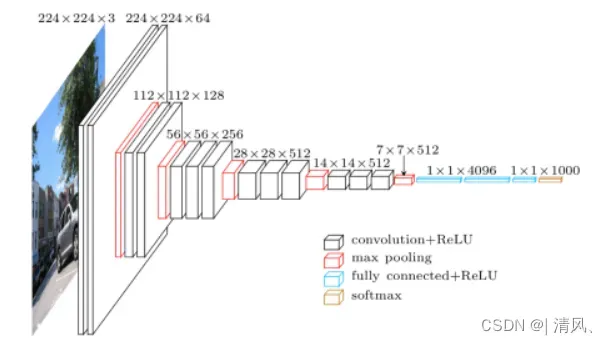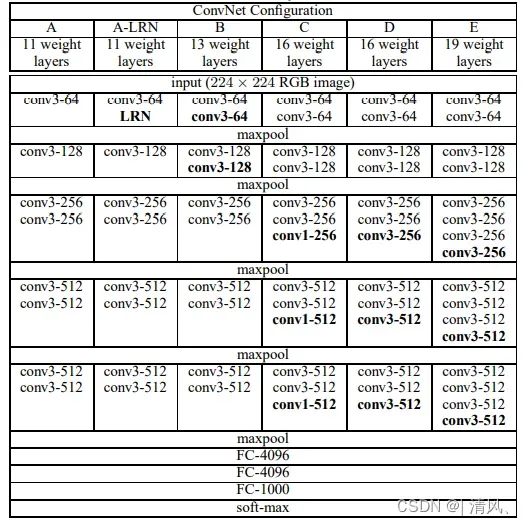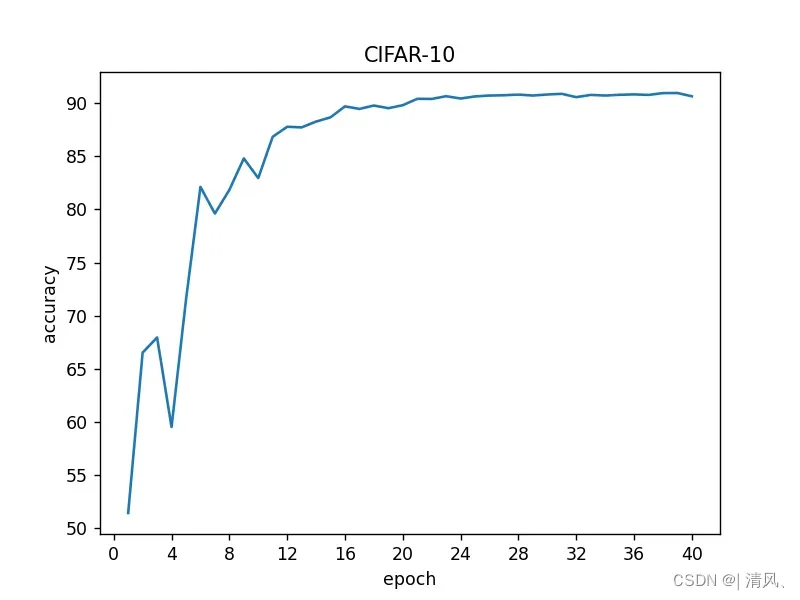文章目录
一、前言
刚入门卷积神经网络,在cifar-10数据集上复现了LeNet、AlexNet和VGG-16网络,发现VGG-16网络分类准确率最高,之后以VGG-16网络为基础疯狂调参,最终达到了90.97%的准确率。(继续进行玄学调参,可以更高)
二、VGG-16网络介绍
VGGNet是牛津大学视觉几何组(Visual Geometry Group)提出的模型,原文链接:VGG-16论文 该模型在2014年的ILSVRC中取得了分类任务第二、定位任务第一的优异成绩。

整体架构上,VGG的一大特点是在卷积层中统一使用了3×3的小卷积核和2×2大小的小池化核,层数更深,特征图更宽,证明了多个小卷积核的堆叠比单一大卷积核带来了精度提升,同时也降低了计算量。
在论文中,作者给出了5种VGGNet模型,层数分别是11,11,13,16,19,最后两种卷积神经网络即是常见的VGG-16以及VGG-19.该模型的主要缺点在于参数量有140M之多,需要更大的存储空间。

三、VGG-16网络搭建与训练
3.1 网络结构搭建
搭建VGG-16网络,代码如下:
import torch
import torchvision
import torchvision.transforms as transforms
import torch.nn as nn
import torch.optim as optim
import torch.nn.functional as F
import numpy as np
import matplotlib.pyplot as plt
transform_train = transforms.Compose(
[transforms.Pad(4),
transforms.ToTensor(),
transforms.Normalize((0.485, 0.456, 0.406), (0.229, 0.224, 0.225)),
transforms.RandomHorizontalFlip(),
transforms.RandomGrayscale(),
transforms.RandomCrop(32, padding=4),
])
transform_test = transforms.Compose(
[
transforms.ToTensor(),
transforms.Normalize((0.485, 0.456, 0.406), (0.229, 0.224, 0.225))]
)
device = torch.device("cuda:0" if torch.cuda.is_available() else "cpu")
trainset = torchvision.datasets.CIFAR10(root='dataset_method_1', train=True, download=True, transform=transform_train)
trainLoader = torch.utils.data.DataLoader(trainset, batch_size=24, shuffle=True)
testset = torchvision.datasets.CIFAR10(root='dataset_method_1', train=False, download=True, transform=transform_test)
testLoader = torch.utils.data.DataLoader(testset, batch_size=24, shuffle=False)
vgg = [96, 96, 'M', 128, 128, 'M', 256, 256, 256, 'M', 512, 512, 512, 'M', 512, 512, 512, 'M']
class VGG(nn.Module):
def __init__(self, vgg):
super(VGG, self).__init__()
self.features = self._make_layers(vgg)
self.dense = nn.Sequential(
nn.Linear(512, 4096),
nn.ReLU(inplace=True),
nn.Dropout(0.4),
nn.Linear(4096, 4096),
nn.ReLU(inplace=True),
nn.Dropout(0.4),
)
self.classifier = nn.Linear(4096, 10)
def forward(self, x):
out = self.features(x)
out = out.view(out.size(0), -1)
out = self.dense(out)
out = self.classifier(out)
return out
def _make_layers(self, vgg):
layers = []
in_channels = 3
for x in vgg:
if x == 'M':
layers += [nn.MaxPool2d(kernel_size=2, stride=2)]
else:
layers += [nn.Conv2d(in_channels, x, kernel_size=3, padding=1),
nn.BatchNorm2d(x),
nn.ReLU(inplace=True)]
in_channels = x
layers += [nn.AvgPool2d(kernel_size=1, stride=1)]
return nn.Sequential(*layers)
该结构相比传统的VGG-16有一些小小的改动:
(1)前两层卷积神经网络中把通道数从64改为了96。(玄学调参,准确率有一丁点的提升)
(2)在全连接层中把每一层的神经元Dropout概率从0.5调成了0.4。对于Dropout的概率值,个人感觉在该数据集中设为0.5并不是一个较好的选择,这会使得最后训练过程中的running_loss卡在400-500之间,无论把学习率调得多小也学不动了。在准确率上的体现就是,Dropout设为0.5时模型在测试集上的分类准确率一直在卡在89%左右,无法突破90%,而设为0.4之后就立刻提升到了接近91%,running_loss最终降到300左右。据此推测,继续调整Dropout参数可以让该模型的准确率在此基础上进一步提升(在此并没有尝试)。
在搭建该网络的过程中总结出的一些心得体会:
(1)对图像的预处理、数据增强的工作要做好。这可以让训练集更丰富,就像在五年高考真题中又衍生出了三年模拟题让神经网络学习,可以让模型更具有泛化能力,防止过拟合。根据原数据集的特点进行合适的数据增强(并不是所有的数据增强操作都可以提升准确率,有些操作加了反而会使得准确率下降),对分类准确率的提升是立竿见影的。
(2)batch_size不要设得太小。一开始的时候batch_size的值设成了4,结果一轮epoch需要训练12000次,即使用GPU跑也很耗时间。设成了24就比之前的快得多了(当然还可以设得更大一些)
3.2 模型训练
代码如下:
model = VGG(vgg)
# model.load_state_dict(torch.load('CIFAR-model/VGG16.pth'))
optimizer = optim.SGD(model.parameters(), lr=0.01, weight_decay=5e-3)
loss_func = nn.CrossEntropyLoss()
scheduler = optim.lr_scheduler.StepLR(optimizer, step_size=5, gamma=0.4, last_epoch=-1)
total_times = 40
total = 0
accuracy_rate = []
def test():
model.eval()
correct = 0 # 预测正确的图片数
total = 0 # 总共的图片数
with torch.no_grad():
for data in testLoader:
images, labels = data
images = images.to(device)
outputs = model(images).to(device)
outputs = outputs.cpu()
outputarr = outputs.numpy()
_, predicted = torch.max(outputs, 1)
total += labels.size(0)
correct += (predicted == labels).sum()
accuracy = 100 * correct / total
accuracy_rate.append(accuracy)
print(f'准确率为:{accuracy}%'.format(accuracy))
for epoch in range(total_times):
model.train()
model.to(device)
running_loss = 0.0
total_correct = 0
total_trainset = 0
for i, (data, labels) in enumerate(trainLoader, 0):
data = data.to(device)
outputs = model(data).to(device)
labels = labels.to(device)
loss = loss_func(outputs, labels).to(device)
optimizer.zero_grad()
loss.backward()
optimizer.step()
running_loss += loss.item()
_, pred = outputs.max(1)
correct = (pred == labels).sum().item()
total_correct += correct
total_trainset += data.shape[0]
running_loss += loss.item()
if i % 1000 == 0 and i > 0:
print(f"正在进行第{i}次训练, running_loss={running_loss}".format(i, running_loss))
running_loss = 0.0
test()
scheduler.step()
# torch.save(model.state_dict(), 'CIFAR-model/VGG16.pth')
accuracy_rate = np.array(accuracy_rate)
times = np.linspace(1, total_times, total_times)
plt.xlabel('times')
plt.ylabel('accuracy rate')
plt.plot(times, accuracy_rate)
plt.show()
print(accuracy_rate)在训练网络的过程中总结出的一些心得体会:
(1)优化器使用SGD更好些,Adam一开始收敛速度确实较快,但是后期可能会出现模型难以收敛的情况。
(2)引入scheduler对学习率进行动态调整非常有效。训练初期为了加速收敛,可以把学习率设得大一些,在此设成了0.01,running_loss下降得很快;而在训练中后期,需要使用更小的学习率来一点点地推进。为了实现这种效果,第一种方案是不断保存模型的参数,之后修手动修改学习率再加载参数继续训练,第二种方案是使用lr_scheduler提供的各种动态调整方案进行动态调整。在此使用StepLR等间隔调整学习率,总的epoch是40次,每隔5次将学习率调整为原来的0.4(玄学调参)。在训练过程中可以很明显地看到,每隔5个epoch调整学习率之后,分类准确率相比上一个epoch突然有了很大的提升。
3.3 训练结果
完整代码如下:
import torch
import torchvision
import torchvision.transforms as transforms
import torch.nn as nn
import torch.optim as optim
import torch.nn.functional as F
import numpy as np
import matplotlib.pyplot as plt
transform_train = transforms.Compose(
[transforms.Pad(4),
transforms.ToTensor(),
transforms.Normalize((0.485, 0.456, 0.406), (0.229, 0.224, 0.225)),
transforms.RandomHorizontalFlip(),
transforms.RandomGrayscale(),
transforms.RandomCrop(32, padding=4),
])
transform_test = transforms.Compose(
[
transforms.ToTensor(),
transforms.Normalize((0.485, 0.456, 0.406), (0.229, 0.224, 0.225))]
)
device = torch.device("cuda:0" if torch.cuda.is_available() else "cpu")
trainset = torchvision.datasets.CIFAR10(root='dataset_method_1', train=True, download=True, transform=transform_train)
trainLoader = torch.utils.data.DataLoader(trainset, batch_size=24, shuffle=True)
testset = torchvision.datasets.CIFAR10(root='dataset_method_1', train=False, download=True, transform=transform_test)
testLoader = torch.utils.data.DataLoader(testset, batch_size=24, shuffle=False)
vgg = [96, 96, 'M', 128, 128, 'M', 256, 256, 256, 'M', 512, 512, 512, 'M', 512, 512, 512, 'M']
class VGG(nn.Module):
def __init__(self, vgg):
super(VGG, self).__init__()
self.features = self._make_layers(vgg)
self.dense = nn.Sequential(
nn.Linear(512, 4096),
nn.ReLU(inplace=True),
nn.Dropout(0.4),
nn.Linear(4096, 4096),
nn.ReLU(inplace=True),
nn.Dropout(0.4),
)
self.classifier = nn.Linear(4096, 10)
def forward(self, x):
out = self.features(x)
out = out.view(out.size(0), -1)
out = self.dense(out)
out = self.classifier(out)
return out
def _make_layers(self, vgg):
layers = []
in_channels = 3
for x in vgg:
if x == 'M':
layers += [nn.MaxPool2d(kernel_size=2, stride=2)]
else:
layers += [nn.Conv2d(in_channels, x, kernel_size=3, padding=1),
nn.BatchNorm2d(x),
nn.ReLU(inplace=True)]
in_channels = x
layers += [nn.AvgPool2d(kernel_size=1, stride=1)]
return nn.Sequential(*layers)
model = VGG(vgg)
# model.load_state_dict(torch.load('CIFAR-model/VGG16.pth'))
optimizer = optim.SGD(model.parameters(), lr=0.01, weight_decay=5e-3)
loss_func = nn.CrossEntropyLoss()
scheduler = optim.lr_scheduler.StepLR(optimizer, step_size=5, gamma=0.4, last_epoch=-1)
total_times = 40
total = 0
accuracy_rate = []
def test():
model.eval()
correct = 0 # 预测正确的图片数
total = 0 # 总共的图片数
with torch.no_grad():
for data in testLoader:
images, labels = data
images = images.to(device)
outputs = model(images).to(device)
outputs = outputs.cpu()
outputarr = outputs.numpy()
_, predicted = torch.max(outputs, 1)
total += labels.size(0)
correct += (predicted == labels).sum()
accuracy = 100 * correct / total
accuracy_rate.append(accuracy)
print(f'准确率为:{accuracy}%'.format(accuracy))
for epoch in range(total_times):
model.train()
model.to(device)
running_loss = 0.0
total_correct = 0
total_trainset = 0
for i, (data, labels) in enumerate(trainLoader, 0):
data = data.to(device)
outputs = model(data).to(device)
labels = labels.to(device)
loss = loss_func(outputs, labels).to(device)
optimizer.zero_grad()
loss.backward()
optimizer.step()
running_loss += loss.item()
_, pred = outputs.max(1)
correct = (pred == labels).sum().item()
total_correct += correct
total_trainset += data.shape[0]
running_loss += loss.item()
if i % 1000 == 0 and i > 0:
print(f"正在进行第{i}次训练, running_loss={running_loss}".format(i, running_loss))
running_loss = 0.0
test()
scheduler.step()
# torch.save(model.state_dict(), 'CIFAR-model/VGG16.pth')
accuracy_rate = np.array(accuracy_rate)
times = np.linspace(1, total_times, total_times)
plt.xlabel('times')
plt.ylabel('accuracy rate')
plt.plot(times, accuracy_rate)
plt.show()
print(accuracy_rate)下面附上运行上述代码在测试集上得到的分类准确率变化折线图:

四、总结
VGG网络确实算是古董了,如果想进一步提升准确率,可以考虑使用ResNet之类的结构。2022年发表的论文里把cifar-10分类的准确率做到了99.612%,实在是太猛了……
文章出处登录后可见!
